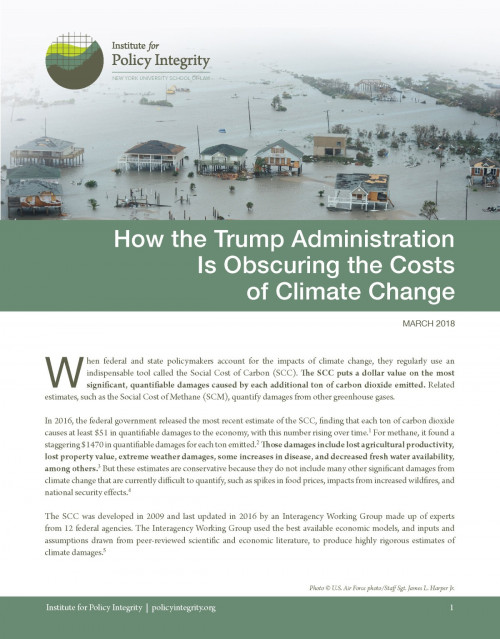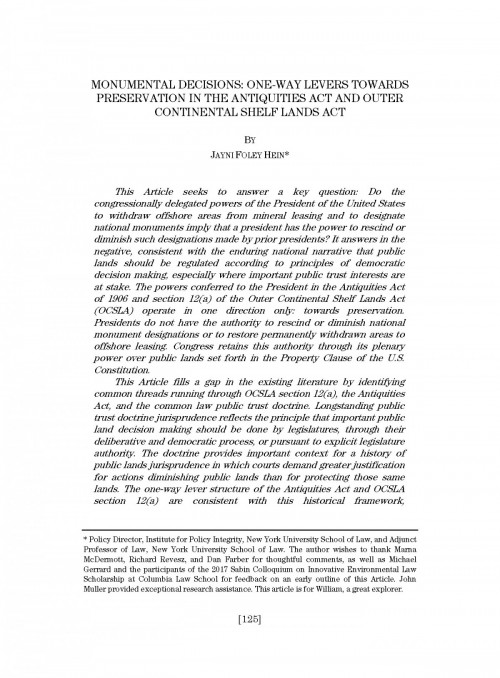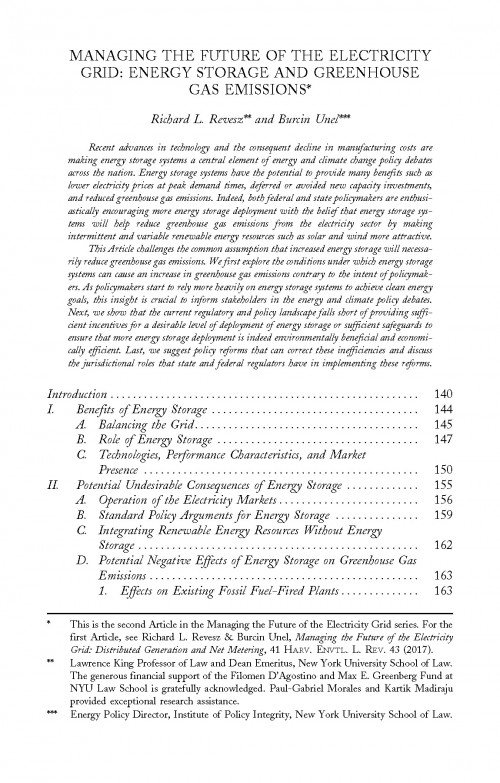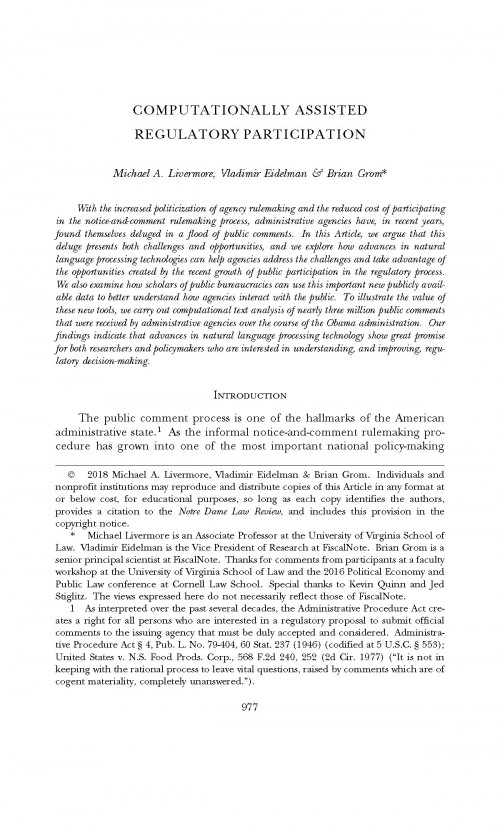-

How the Trump Administration Is Obscuring the Costs of Climate Change
When federal and state policymakers account for the impacts of climate change, they regularly use a tool called the Social Cost of Carbon (SCC). The SCC puts a dollar value on the most significant, quantifiable damages caused by each additional ton of carbon dioxide emitted. The most recent estimate of the cost is at least $51 per ton and rising over time. But now, turning its back on years of work, the Trump administration has disbanded the federal group that developed the SCC, and produced a new “interim” estimate claiming that each ton of carbon dioxide causes as little as $1 in climate damages. This issue brief describes how the Trump Administration reached this misleading number by ignoring the interconnected, global nature of our climate-vulnerable economy and obscuring the devastating effects that climate change will have on younger and future generations. Though the administration has been proposing rollbacks of environmental rules using this problematic SCC estimate as justification, we explain why federal agencies and state governments should continue using the most recent estimate by the Interagency Working Group that developed the SCC.
-

Valuing Pollution Reductions
How to Monetize Greenhouse Gas and Local Air Pollutant Reductions from Distributed Energy Resources
Distributed energy resources (DERs)—grid-connected, small-scale electric generators such as rooftop solar installations, micro-turbines, combined heat and power systems, customer backup generators, and distributed energy storage systems—are a growing part of the U.S. electric system. They can help avoid the high levels of greenhouse gases and local air pollution produced by traditional energy sources. As their use grows, state electric utility regulators are seeking to compensate DERs accurately for the benefits they offer, including reductions in pollution that contributes to climate change and harms human health. This report shows how regulators can calculate the types and amount of pollution avoided, and then monetize these benefits for use in policy.
-

Federal Lands and Fossil Fuels: Maximizing Social Welfare in Federal Energy Leasing
Published in the Harvard Environmental Law Review.
The Department of the Interior is tasked with managing the nation’s mineral resources and must earn a “fair market value” for the use of federal lands and resources. But in recent years, Interior’s coal, oil, and natural gas leasing programs have been criticized for failing to keep pace with developments in modern technology, shortchanging taxpayers, and failing to adequately account for climate change and other environmental effects. This article, published in the Harvard Environmental Law Review, suggests a rational path forward for federal fossil fuel leasing. Just as a private company would seek to maximize net revenue in its operations, Interior should seek to manage its program to provide maximum net benefits to the public, to whom public resources belong. This includes accounting for all of the costs and benefits of leasing—including environmental and social costs—and adjusting the fiscal terms of its fossil fuel leases to recoup unmitigated externality costs.
-
Brief on Deferred Action for Childhood Arrivals Program
In September 2017, the Department of Homeland Security (DHS) issued a memorandum rescinding the Deferred Action for Childhood Arrivals program (DACA), which had protected certain young people who were brought to the U.S. as children from deportation. A variety of plaintiffs—including the Regents of the University of California; several states, counties, and municipalities; and individual program participants—promptly challenged DHS’s decision in the U.S. District Court for the Northern District of California and secured a preliminary injunction blocking DHS from carrying out the rescission. DHS has now appealed that injunction to the U.S. Court of Appeals for the Ninth Circuit. Our brief, which urges the court to affirm the district court’s injunction, addresses only one issue in the case: DHS’s contention that it had a reasonable basis for rescinding DACA based on the “evident risk” that the program “would at a minimum be the subject of protracted litigation, and very likely be enjoined nationwide.”
-

Monumental Decisions: One-Way Levers towards Preservation in the Antiquities Act and Outer Continental Shelf Lands Act
Published in Environmental Law Review
In new legal scholarship published in Environmental Law Review, Jayni Hein argues that the powers granted to the President in the Antiquities Act and Outer Continental Shelf Lands Act (OCSLA) operate in one direction only: towards preservation. Presidents do not have the authority to rescind or diminish national monument designations, nor to re-open previously withdrawn areas to offshore leasing. Congress, alone, retains this authority over public lands.
-

Managing the Future of the Electricity Grid: Energy Storage and Greenhouse Gas Emissions
Recent advances in technology and the consequent decline in manufacturing costs are making energy storage systems a central element of energy and climate change policy debates across the nation. Energy storage systems have the potential to provide many benefits such as lower electricity prices at peak demand times, deferred or avoided new capacity investments, and reduced greenhouse gas emissions. Indeed, both federal and state policymakers are enthusiastically encouraging more energy storage deployment with the belief that energy storage systems will help reduce greenhouse gas emissions from the electricity sector by making intermittent and variable renewable energy resources such as solar and wind more attractive. This article, published in the Harvard Environmental Law Review, challenges this common assumption that increased energy storage will necessarily reduce greenhouse gas emissions.
The article was selected by Environmental Law Reporter as one of the five best environmental law articles published during the 2018-2019 academic year. An adapted version, The Future of Energy Storage: Adopting Policies for a Cleaner Grid, was included in the August 2019 Environmental Law and Policy Annual Review issue of Environmental Law Reporter’s News & Analysis.
-
Comments to California on Its Cap and Trade Program
California has legislation authorizing its Air Resources Board (ARB) to extend its cap-and-trade program for carbon emissions. This extension, while defining much of the program’s structure, asks ARB to develop some design features through a regulatory process and public feedback. California’s most recent changes to the plan are consistent with our previous comments on the program, and they place California on the path to internalizing the cost of climate change from carbon emissions. Our most recent set of comments encourage ARB to continue to set the price ceiling for carbon permits at least as high as the Social Cost of Carbon set by the Interagency Working Group in 2016, as it does in its Concept Paper on carbon pricing. We also encourage ARB to allocate preferentially any unsold carbon allowances to the price ceiling, rather than to a lower price.
-
Comments on California PUC Order Instituting Rulemaking to Create a Consistent Regulatory Framework for the Guidance, Planning, and Evaluation of Integrated DERs
California has long been a trendsetter in clean energy policy, and our input helped inform the state’s approach for evaluating distributed energy resources (DERs), such as rooftop solar installations. The state’s new approach, which will quantify the environmental benefits of DERs, could help influence other policies around the country, boosting the growth of clean energy sources. Our comments to the California Public Utilities Commission were heavily cited in a March 2018 administrative law judge ruling, which, if adopted by the Commission, would require utilities to conduct a societal cost test to determine the cost-effectiveness of DERs.
-
Brief Challenging Suspension of NHTSA Rule on Fuel Economy Penalties
In 2017, the National Highway Traffic Safety Administration (NHTSA) suspended its 2016 Civil Penalties Rule, which adjusted the penalties for automobile manufacturer non-compliance with fuel economy standards for the first time in decades to reflect inflation. In issuing its suspension, NHTSA claimed that it was causing no harm. Our brief in the case challenging this suspension shows that NHTSA’s claim of no harm was inaccurate.
-

Computationally Assisted Regulatory Participation
With the increased politicization of agency rulemaking and the reduced cost of participating in the notice-and-comment rulemaking process, administrative agencies have, in recent years, found themselves deluged in a flood of public comments. In this article, published in the Notre Dame Law Review, the authors argue that this deluge presents both challenges and opportunities, and they explore how advances in natural language processing technologies can help agencies address the challenges and take advantage of the opportunities created by the recent growth of public participation in the regulatory process.





